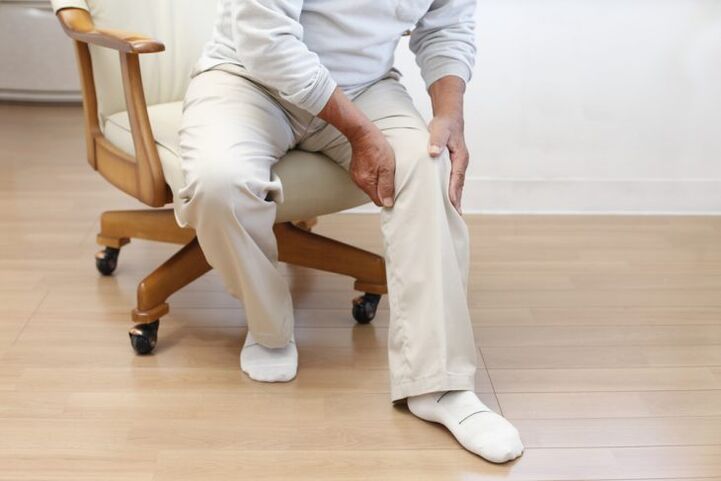Of all the joints in the human body, knee pain is the most common human complaint. The knee joint is complex, it bears a lot of stress in different types of physical activity, so there can be many reasons for pain. Knee pain, even if it occurs occasionally and goes away on its own, shouldn't go unnoticed.
Causes of knee pain

- Gonarthrosis or osteoarthritis of the knee joint. This disease is caused by excessive stress, trauma, obesity, metabolic disorders. The pain usually occurs during and after physical activity, including climbing stairs, running, squatting, and gradually subsides with rest. Painful sensations are combined with a painful crunch in the joints, followed by swelling, deformation of the knee contours, restrictions and pain in movement. So-called patellofemoral (femur-patella) osteoarthritis, in which the joint between the kneecap and the articular surface of the thigh bone wears out, is common and in young people.
- Damage to the menisci. The knee joint has two cartilage formations - the inner and outer menisci, which provide better shock absorption. The medial meniscus suffers more often. It is important to know what traumatic meniscal injuries and degenerative injuries are differentiated between. The first occurs with a sharp turn of the body, when the foot is fixed, jumps, falls. The pain is acute, the swelling of the joint develops rapidly, blood accumulates in its cavity, as a result of which swelling appears over the kneecap. The knee may not be fully extended or the victim may have a sensation of wedging, a "popping out" sensation of a foreign object in the joint. Degenerative meniscus ruptures occur mainly in older people with osteoarthritis of the knee. They can easily appear while walking, trying to sit on a low seat or carry a weight. The pain gradually increases, accompanied by swelling, synovitis (inflammatory fluid in the joint cavity). Meniscal injuries also cause pain when the lower leg rotates (this is what clinical tests conducted by the doctor assume) when walking down stairs.
- Damage to the ligamentous apparatus. Traumas more common than or in connection with meniscal tears. The knee joint has the outer and inner collateral ligament, the anterior and posterior cruciate ligament and the patellar ligament. Collateral ligaments are more often affected when the lower leg is deflected outward or inward from the axis of the extremity. The cruciate ligaments are damaged by twisting the lower leg, hitting it. In a traumatic dislocation, the kneecap's own ligament tears. Ligamentous apparatus injuries are characterized by pain that is aggravated by walking, support on the leg. In addition, with significant damage, instability of the knee joint occurs in one plane or another.
- Arthritis. Inflammation of the knee joint, infectious or non-infectious in nature. The person feels constant pain that increases with exertion. The joint is swollen, enlarged, feels hot, the skin is reddened. The general body temperature can also rise.
- Rheumatoid arthritis. It is an autoimmune disease that affects many joints, often the knee. The pain in this case is of an inflammatory nature; H. the patient complains about it quietly, especially after the night. Exercise improves blood circulation and pain is relieved. The pain is accompanied by persistent (more than half an hour) stiffness. There are other signs of joint inflammation as well: swelling, redness, increased skin temperature over it.
- Tumors of the knee joint. Pain is not a permanent symptom of tumors. It may not be present on small formations, as may other characters. However, when the tumor grows and affects all new structures in the joint, the patient begins to complain of pain. They are not associated with physical activity, more often disturbed in the second half of the night and in the morning.
- Osteochondropathy. These are lesions of the articular surfaces. In the knee joint, Koenig's disease can develop - osteochondropathy of the inner condyle of the thigh, while the cartilage is destroyed and its fragments can be freely localized in the joint cavity, which leads to an inflammatory process and blockage of the joint. The pain is felt during exertion, with the development of the disease and at rest.
treatment
Pain is just a symptom of an illness. Its nature, location, stress dependency, time of day, along with other symptoms, help to make a preliminary diagnosis.
Treatment should primarily aim to eliminate a particular disease or, if that is not possible, achieve long-term remission (a period without exacerbations) to prevent its progression.
Treatment methods can be conservative or surgical.
Symptomatic pain management is primarily a group of drugs such as nonsteroidal anti-inflammatory drugs. They are used in the form of intravenous, intramuscular injections, tablets, capsules, rectal suppositories, and topically (ointments, gels, creams, aerosols).
For many diseases, the doctor can prescribe physical methods of treatment: physiotherapeutic procedures, dry heat or baths, semi-alcoholic compresses, therapeutic exercises in the gentle mode, wearing a bandage or an orthosis.
Such therapy, along with medication, will help improve blood circulation, reduce inflammation, and relieve pain. If the pain is mechanically caused (part of a meniscus tear blocks a joint, a free cartilage body) or if conservative therapy is ineffective, surgical techniques are used: joint debridement through arthroscopy, osteotomy, knee joint replacement with an artificial joint closure (arthrodesis).
If you have knee pain, you should see an orthopedic surgeon or traumatologist (if an injury has occurred).



























